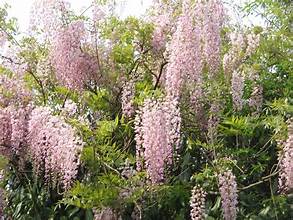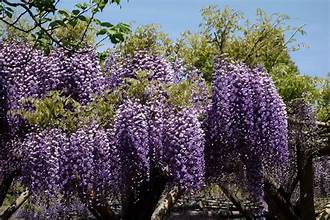Wisteria trees, celebrated for their cascading blooms and delicate fragrance, are a beautiful, hardy, and long-living addition to any garden. With blue to purple flowers, they thrive in the spring and early summer, often gracing pergolas and archways. However, wisteria vines grow quickly and can become quite heavy, making them unsuitable for planting too close to homes due to their invasive nature.
Proper planting and care can yield a stunning, easy-to-grow tree that is deer and drought resistant, attracting butterflies and hummingbirds. This guide provides essential steps for planting, growing, and maintaining a healthy wisteria trees.

Overview of Wisteria trees
Scientifically referred to as Wisteria spp., this deciduous perennial vine is well-known for its cascading flower clusters. It belongs to the Fabaceae family. Often called wisteria, it comes in different types such American, Japanese, and Chinese wisteria.
Wisteria thrives in USDA hardiness zones 5 through 9, and it prefers well-drained soil that is slightly acidic to neutral in pH. It also prefers full sun exposure over partial shade. Wisteria is a native of the Northern Hemisphere that is prized for its decorative value in gardens and landscapes. It provides appeal with its profusion of blossoms.
How to care for Wisteria trees
It’s important to comprehend the fundamentals of general wisteria tree care before getting into the specifics of planting and caring for a wisteria tree. For optimal growth, wisteria trees require light, well-drained soil, moisture, warmth, and humidity. Let’s explore in more detail.
Light and soil
Wisteria trees thrive in full sunlight, requiring at least 6 hours of direct sun daily. It’s crucial to plant them in a location free from shading by other trees or structures. In regions with hot summers, consider providing partial shade during the hottest part of the day to prevent leaf scorching.
For optimal growth, wisteria prefers deep, moist, and well-drained soil with a pH range of 6.0-7.0. Ensure the soil is nutrient-rich by incorporating compost or well-rotted manure before planting. Avoid compacted soil, as it hinders root development essential for the tree’s health and vigor.
Water
Wisteria trees require regular irrigation, especially in the summer and during dry, hot weather. Compared to older trees, younger trees need to be watered more frequently. Sustain the soil’s moisture content to keep it damp but not soggy; excessive watering can cause deadly root rot. The tree becomes more resilient to drought stress when it receives deep irrigation, which promotes the formation of deep roots.
Humidity and Temperature
Wisteria trees prefer a humid atmosphere and can withstand temperatures between 55°F and 75°F. Excessive humidity can encourage fungal diseases, whereas extreme dryness may result in leaf drop. The ideal maintenance and health of wisteria trees depend on maintaining a balance between temperature and humidity.
Fertilizer
Apply a 2-inch layer of mulch in the spring and compost beneath the plant once a year to improve moisture retention and discourage weed growth. Incorporate phosphorus for better flowering by applying rock phosphate in the autumn and bone meal in the spring.
Steer clear of nitrogen fertilizers because wisterias fix nitrogen from the air organically through their roots. These procedures support wisteria trees’ vigorous blossoms and robust growth.
Pruning
For wisteria trees to bloom and control growth, regular pruning is essential. To encourage the growth of the main stem, start by pruning off low-growing branches. Continue to prune lower sprouts as the tree grows in order to preserve its shape and focus growth towards the top.
The tree’s top should be pruned on a regular basis to keep it from growing too big or encroaching. Before new growth appears, prune in late winter or early spring. To preserve vigor and flowering potential, remove diseased, dead, or damaged branches and clip back lateral shoots to two or three buds.
How to grow Wisteria trees from seed
Wisteria trees are difficult to grow from seed and are usually not advised. A tree cultivated from seeds may take 8 to 10 years to reach maturity and blossom. It’s ideal to get a young wisteria tree from a nursery and transplant it into your yard for faster results. But if you’re interested in trying, you should know that growing wisteria trees from seed comes with certain unique considerations and difficulties.
The seeds must first be scarified. This is cracking the tough outer layer to allow for the infiltration of water and the germination of seeds. This can be accomplished by gently rubbing the seeds with sandpaper or soaking them in warm water for a whole day.
Stratification comes after the seeds have been scarified. To do this, the seeds must be exposed to low temperatures that simulate those of winter. To achieve this, put the scarified seeds in a plastic bag with vermiculite or damp sand, and refrigerate for three to four months. The seeds are better prepared for germination by this method.
After the seeds have been stratified, place them in a pot with soil that drains properly. As you move the pot into a warm, sunny place, make sure the soil is moist but not soggy. It could take a few weeks to several months for germination to occur, so please be patient.
The seedlings can be moved into bigger pots or straight into your garden once they are a few inches tall. Recall that wisteria trees are hardy plants that can reach considerable heights, so make sure you leave enough room for them to flourish.
It’s important to know that some wisteria seeds will not germinate, even with proper scarification and stratification. Because of this unpredictability, buying a young tree from a nursery is frequently advised instead.
How to propagate Wisteria Trees

The magnificent, cascading blossoms of wisteria trees are well known for adding grace and beauty to any garden. There are a few options to think about if you like wisteria and want to grow your own.
Propagation of Wisteria by cuttings
Taking cuttings of wisteria trees, preferably in late winter or early spring, before the growing season begins, is an efficient approach to propagate the tree.
To start, select a healthy branch that is about 6 inches long from the wisteria tree. Make a clean, accurate cut right below a node with sharp pruning shears. Take off any lower leaf or flower buds from the cutting.
Then, to encourage the growth of roots, immerse the cutting’s cut end into a powdered rooting hormone. Make sure the cutting’s lower half is submerged when planting it in a container of sandy soil. To keep the pot moist, cover it with a plastic bag and set it in a shaded area.
Water the cutting frequently to keep the soil moist and prevent waterlogging. The emergence of roots should occur in a few weeks. You can move the cutting into a bigger container or straight into the ground once its roots have taken hold.
Propagation by Layering
Layering is an additional method of wisteria tree propagation. With this technique, a tree branch is buried in the ground until it forms roots, at which point it can be chopped off and replanted.
Start by selecting a low-growing branch that grows close to the ground on the wisteria tree. Make a little incision about 12 inches from the tip on the bottom of the branch with sharp pruning scissors.
Bend the branch gently down to the ground, leaving the tip exposed, and bury the cut piece in the earth. Using a U-shaped wire or a small rock, fasten the branch to the ground to keep it in place.
Water the area frequently to keep the soil moist, and be patient while it takes several months for roots to form. After the roots have taken hold, trim the branch off of the main tree and put it in the ground or in a pot.
You may enjoy your own wisteria tree’s lovely blooms for many years by reproducing it yourself with patience and the right care.
Typical Plant Diseases and Pests for Wisteria Trees
Despite their beautiful appearance, wisteria trees are prone to a number of frequent problems. Fungal diseases that cause discoloration and wilting of leaves include powdery mildew, leaf spot, and root rot. It’s critical to maintain adequate airflow around the plant, refrain from overwatering, and use the proper fungicidal treatments as needed in order to prevent these illnesses. Another fungal issue that can cause discoloration and leaf loss is mildew, which grows best in warm, humid environments.
Wisteria trees are prone to pests including aphids and scale insects in addition to fungal diseases. Little, soft-bodied insects called aphids are responsible for the curling, yellowing, and occasionally falling off of leaves. By sucking sap, scale insects, which resemble brown lumps on stems and leaves, can damage plants.
Prompt response and routine inspection are essential for managing these pests. These problems may be managed and your wisteria tree will stay healthy and vibrant in your yard by using insecticides, cutting damaged areas, and upholding general plant health with routine maintenance procedures.



Pingback: Verbena Flower, How to grow and care (Complete guide)
Awesome page with genuinely good material for readers wanting to gain some useful insights on that topic! But if you want to learn more, check out QU6 about Thai-Massage. Keep up the great work!